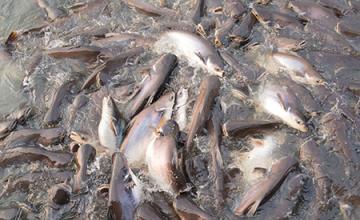The Future of Tasty Fish

Photo courtesy of Adobe Stock.
Catfish and rainbow trout are two fish that are high in protein, potassium, and other vitamins and nutrients. They are very popular fish among consumers and part of the largest aquaculture industries in the United States. In 2021, these markets had sales of over $400 million total.
Maintaining a good quality fish fillet is essential for this industry to continue prospering.
ARS researchers Ryan Ardoin, Rebecca Dupre, and Brennan Smith are working on different ways to improve the quality of fish fillets. One of the main causes of monetary losses in the catfish industry is “off,” flavor, which can affect any fish species grown in aquaculture. Compounds like geosmin, which is produced by blue-green algae and other microorganisms, are commonly found in both pond-based aquaculture and Recirculating Aquaculture Systems (RAS). These compounds are not hazardous but are responsible for the majority of the taste and odor defects in drinking water. When present in water used to grow fish, it is absorbed into the tissue and can cause the fish to develop a muddy taste and aroma. Geosmin is an easily detected odor for humans, who can smell it even at extremely low concentrations.
“The whole project is trying to mitigate and to find ways to prevent the geosmin from ever happening,” explained Brennan Smith, Research Leader at the Food Processing and Sensory Quality Research Center in New Orleans, LA.
An important part of the testing has been creating a system for reproducibly and accurately introducing off-flavors into fish in order to refine methods of geosmin detection and to determine human thresholds of detection. In this case, researchers used rainbow trout in a raceway system, where spring water continuously flows through concrete channels to prevent accumulation of geosmin in the water. The fish were given a feed that was spiked with geosmin. Researchers realized that the levels of geosmin in the fish were proportional to what was in the feed.
The motivation behind the study was to investigate if exposure to geosmin through feed leads to detectable geosmin levels in rainbow trout. By using a controlled approach of incorporating geosmin into the fish’s diet, the researchers are able to investigate techniques for eliminating the unwanted flavors and enhancing the overall appeal of farmed fish products.
“We figured out the instrumental methods for detecting geosmin,” explained Smith. “And so now, for the first time, we can do quantitative work and we can actually put a number on the levels of geosmin, which we can use to actually define thresholds at which consumers can detect the flavors and thresholds at which a consumer would reject these off flavors.”
The study also aims to promote the fish farming industry by finding ways to facilitate the production of fish in aquaculture systems while providing a high-quality product. Researchers believe that it’s important to produce good quality fillets, because eating fish can add a lot of nutritional value to our diets. Ultimately, in ensuring a good taste, ARS researchers are helping consumers and fish farmers alike, by providing more options for healthy eating and higher-quality products for selling. By Olga Vicente, ARS’s Office of Communications.
You May Also Like:

